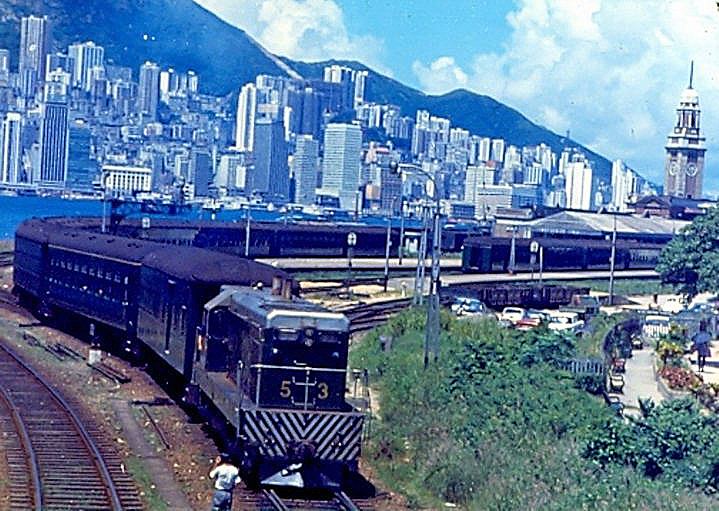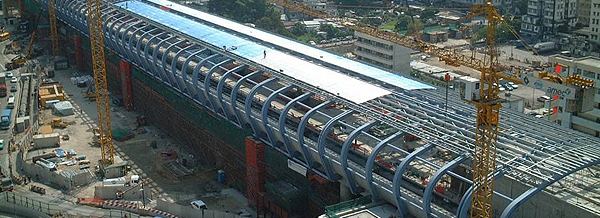 | ||
Transit type Suburban railRegional railLight rail Number of stations 33 railway stations, 68 light rail stations Daily ridership about 1.49 million (2006) Began operation 1 October 1910 (operation taken over by MTR Corporation Limited (MTRCL) since 2 December 2007) | ||
The Kowloon–Canton Railway (KCR; Traditional Chinese: 九廣鐵路) is a railway network in Hong Kong. It is owned, and was operated by the Kowloon–Canton Railway Corporation until 2007. It provides rapid transit services, a light rail system and feeder bus routes within Hong Kong, and intercity passenger and freight train services to Mainland China.
Contents
- Before 1949
- An expanding network
- Takeover by MTRCL
- Express Rail Link proposal
- Kowloon Southern Link
- Criticism of ontrain advertising
- Fares and tickets
- Octopus card
- Feeder Buses
- Service Vehicles
- Northern Link
- Sha Tin to Central Link
- Historic
- Facilities
- Tunnels
- References

While still owned by its previous operator, Kowloon–Canton Railway Corporation (which is wholly owned by the Hong Kong Government), the network has been operated by the MTR Corporation Limited under a 50-year, extendible, service concession since 2 December 2007. Steps have been taken to assimilate the network into the same faring system of the MTR, and gates between the two networks were removed in several stages in 2008.

In 2006, the local KCR passenger train network (i.e. intercity services excluded) recorded an annual ridership of 544 million.
Before 1949

After the Chinese civil war and the victory of the Communists in mainland China in 1949, through-trains were no longer able to cross the border until the service was resumed in 1979.
An expanding network
The British Section of the original Kowloon–Canton Railway was originally operated by a department within the Hong Kong Government. Following the government's plan to corporatise the operation of the railway, the Kowloon–Canton Railway Corporation (KCRC) was established in December 1982, with the government remaining as the sole shareholder.
With the development and urbanisation of the New Territories, the British Section became an important corridor to connect the new towns in eastern New Territories with urban Kowloon. Electrification and conversion to a dual-track system was completed in 1984. Since then, the suburban rail became much more metro-like. Frequent service was provided, and in the 1990s trains were refurbished to provide fewer seats and more standing places.
In 1984, the KCRC accepted the government's invitation to build and operate a light rail system in northwestern New Territories. The Light Rail Transit (known later as the KCR Light Rail, and now simply the Light Rail) was opened in 1988.
The KCRC won a bid in 1996 to build a "Western Corridor Railway", later branded as the KCR West Rail and opened in 2003. The British Section of the original Kowloon–Canton Railway was renamed KCR East Rail, and the LRT became KCR Light Rail. The names "Kowloon–Canton Railway" or "KCR" has become to refer to the network operated by the KCRC. The KCR Ma On Shan Rail was opened in 2004 as a branch line to the KCR East Rail.
A list of original stations of the KCR British Section:
Takeover by MTRCL
Various proposals to merge the KCRC and the other railway operator in the territory, the MTR Corporation Limited (MTRCL) has been on government's agenda since the 2000s. In 2006, the government, as the sole shareholder of the KCRC, decided that the two railway networks should be merged with the MTRCL being granted a service concession to operate the KCR network for an initial period of 50 years. The decision was passed by the Executive Council on 11 April 2006, and was later approved by the Legislative Council and the minority shareholders of the MTRCL (the government, which had a 75% stake in the MTRCL, did not vote).
It was later decided that the merging of the corporations' two rail networks would take place on 2 December 2007. Since then the KCRC has become a holding company. Under the service concession, the MTRCL pays the KCRC a fixed annual sum of HK$750 million, and from the fourth year after merger of the two networks, a sliding percentage scale share of annual revenue above HK$2.5 billion earned from the KCRC network.
As part of the merger, the KCR East Rail, KCR West Rail and KCR Ma On Shan Rail were renamed East Rail Line, West Rail Line and Ma On Shan Line, respectively. The KCR Light Rail is known simply as the Light Rail. Mong Kok Station on the East Rail was renamed Mong Kok East Station.
Express Rail Link proposal
On 2 August 2007, Chief Executive Donald Tsang announced that, considering the technical requirements, passenger forecast, Hong Kong's future economic development and the closer trade ties between Hong Kong and Guangdong, the new Guangzhou-Shenzhen-Hong Kong Express Rail Link will adopt the dedicated-corridor option after the 10th Plenary of the Hong Kong/Guangdong Co-operation Joint Conference. The Kowloon–Canton Railway Corporation has submitted a detailed project proposal to the government.[3] Because of the merger, however, it is unlikely the Rail Link will be built and operated by the KCRC.
Kowloon Southern Link
The KCRC made proposals to plan, build, and operate the Kowloon Southern Link, receiving permission for the project from the government on 24 September 2002.
The 4.5 km Kowloon Southern Link connects the West Rail Nam Cheong station with the East rail East Tsim Sha Tsui station with an intermediate stop at West Kowloon, later renamed Austin Station. West Rail now runs to Hung Hom station and East Rail retreated its service back to Hung Hom. The station became the interchange between East Rail, West Rail and later, the proposed Sha Tin to Central Link. Journey time from Tin Shui Wai to East Tsim Sha Tsui is 30 minutes.
Disputes on the funding and location of Canton Road station in Tsim Sha Tsui, which was in the proposed alignment, postponed the construction by a year to 2005. Construction started on 7 November 2005. The new link started operation on 16 August 2009.
Criticism of ontrain advertising
In the past few years the subject of invasive marketing has arisen with the advent of television screens on carriages. The first few weeks saw several hundred complaints as the volume level was turned up to maximum in order to help generate revenue from marketing. After several weeks of complaints the company eventually backed down and introduced two 'quiet cars' to the rolling stock offering a peaceful respite for passengers. Other complaints included window advertising which blocked the views outside and caused travel sickness in some passengers. Although windows continue to be obscured making viewing of the exterior difficult and travel less comfortable for passengers, the company has responded to complaints by reducing the size of the advertisements.
Fares and tickets
There were two different fare classes on the KCR: Adult and Concessionary. Only children between the ages of 3 and 12, and senior citizens 65 years or over qualified for the concessionary rate. Like the MTR, the KCR did not provide a concessionary fare for students, although there was a student discount system available for students who lived in Tuen Mun, Yuen Long and Tin Shui Wai. Fares on the East Rail, Ma On Shan Rail, West Rail and the Light Rail (Octopus fare system only) were based on the distance between the start and end points of the journey. The Light Rail implemented a zone-based fare system for single journey tickets; there are six zones in total.
The fare for first-class service on the East Rail was double that of normal fares. Fares to Lo Wu were substantially higher than fares to the station just before, Sheung Shui, because of a tariff imposed on those travelling across the border to mainland China.
There are two payment methods:
Octopus card
In 1998, the MTR and KCR started using the Octopus Access Control System as the main payment method for travel on its network, replacing the Common Stored Value Tickets. Octopus cards are rechargeable, contactless smart cards, thus the value of the money is digitally stored in the card, and the amount can be automatically calculated and deducted by Octopus card readers. The system was originally proposed and introduced by the MTR. It has been extended to different services such as minibuses, franchised buses, supermarkets, and fast food restaurants. It has the potential to be further developed in other fields of services. The older, traditional magnetic ticketing system is also still in use for single journeys.
Using the Octopus card to travel on the KCR was slightly cheaper than using Single Journey Tickets. Various discount schemes on different lines, and free or discounted transfer to other modes of transport have to be done through Octopus Card.
Feeder Buses
Updated: Dec 2009
Service Vehicles
²This steam engine was once used on the Sha Tau Kok Branch Line, but since its closing in 1924, the engine has been displayed in the Tai Po Railway Museum. It has been the only steam engine in Hong Kong for over 40 years (since the KCR last used a steam engine).
³Unit E44 (cars 144-244-444) didn't undergo refurbishment, and #144 is now kept at the Tai Po Railway Museum for display.
4All Kinki Sharyo stock are purchased and imported from Japan.
Northern Link
The Northern Link will be a rail link which connects West Rail and the Lok Ma Chau Spur Line of East Rail. The link will also serve as a connection to the boundary checkpoint into Shenzhen and Guangzhou for passengers of the western part of the New Territories. The Northern Link will start at Kam Sheung Road and end at Lok Ma Chau, where it will co-terminate with the East Rail Lok Ma Chau Spur Line. KCRC proposed to build a station at Chau Tau for interchange between this link and East Rail.
It is reported that the line may be built as a single-track railway to achieve cost-effectiveness. Under some of the earlier proposals, the link will serve as one of the sections of the Regional Express, a new intercity service connecting Hong Kong, Shenzhen and Guangzhou.
Sha Tin to Central Link
On 25 June 2002 the government announced that KCRC had won its bid to build and operate the Sha Tin to Central Link. When the line is completed, the KCR network will cross Victoria Harbour and reach Hong Kong Island for the first time. Later the KCRC announced modification to the proposal, with the East Kowloon portion of the line joining Ma On Shan Rail at Tai Wai, and the cross-harbour portion joining East Rail at Hung Hom. However, the proposal has not been approved by the government yet.
On 11 April 2006, the government has signed a non-binding memorandum of understanding with MTRC and KCRC on merging the two railway companies.
According to the non-binding memorandum of understanding signed with the government, the current MTR lines may fully integrate the interchange stations with the Sha Tin to Central Link in order to bring more convenience to the passengers. Also, the government will conduct further studies on the proposal with the MTRC along with the Kwun Tong Line Extension. According to South China Morning Post, construction will start in 2010.
Historic
Some of these are located at the Hong Kong Railway Museum in Tai Po, but most were scrapped when the KCR changed to modern rolling stock in the 1970s:
Facilities
Tunnels
The KCR lines ran under two main tunnels:
